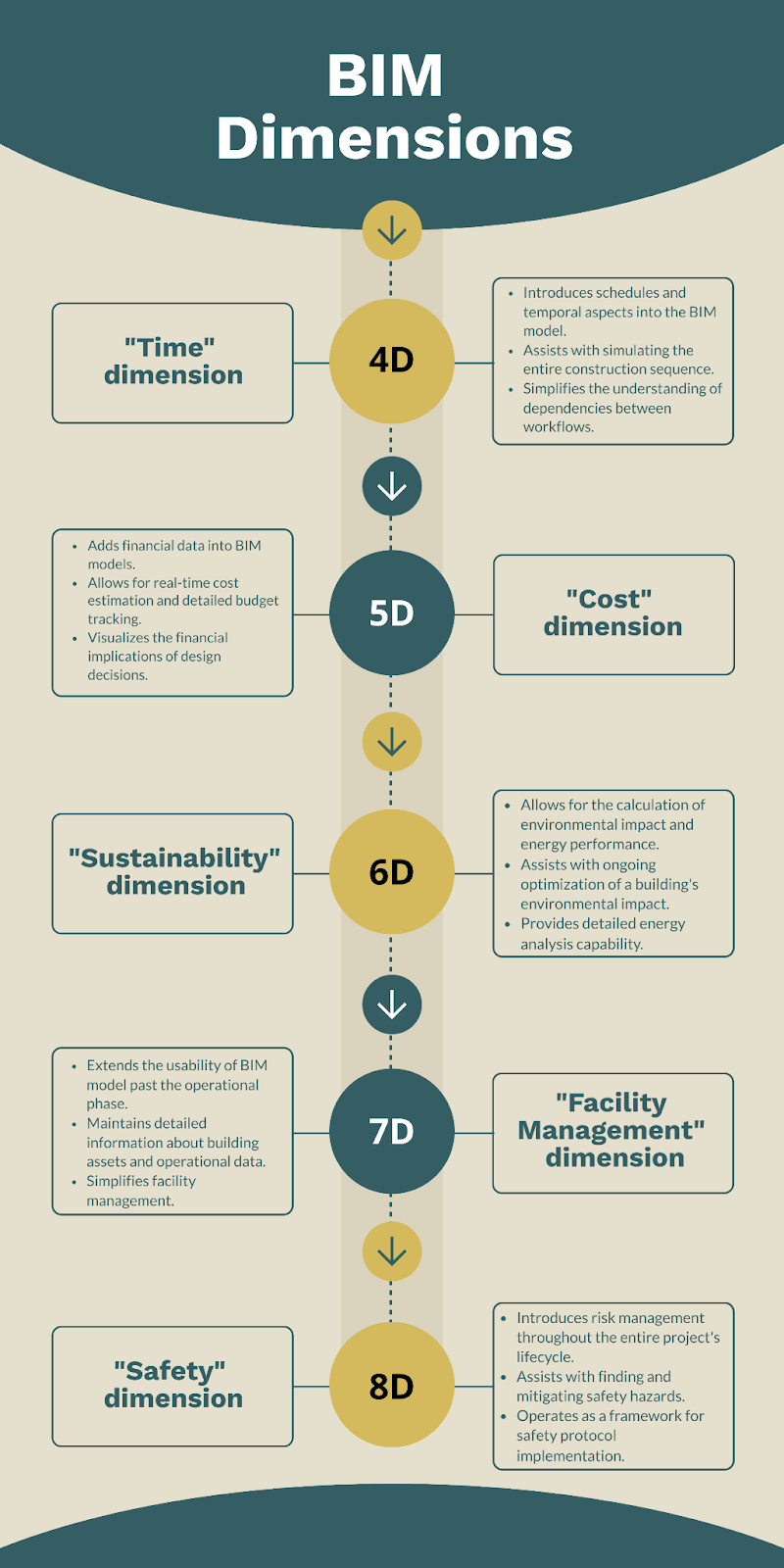What is BIM in construction management? BIM in construction industry.
- Definition of BIM in the construction industry
- Why BIM is so important for the construction industry
- BIM technology in detail
- Case study – Improving communication with BIM
- BIM dimensions
- Benefits of BIM in construction management
- Getting started with implementing BIM in your company
- Standardization and compliance in BIM
- The future of BIM in the industry
- How BIM is changing the construction industry

The construction industry is going through something similar to a digital revolution right now, with BIM at its heart, reshaping design, building, and the management of construction processes. Building information modeling has become practically irreplaceable in recent years, quickly becoming a mandatory approach to construction workflows for every company that wants to stay competitive and keep up with the performance of the rest of the market.
The industry itself is experiencing steady growth, with some of the most recent projections stating that the market will be valued at $11.96 billion by 2027 (source: Fortune Business Insights), which is more than double its pre-COVID pandemic evaluation of $5.71 billion in 2020. With that being said, most BIM users are only scratching the surface of what BIM can achieve, considering how much more BIM can do for the entire project lifecycle from start to finish.
Definition of BIM in the construction industry
So, what is BIM in construction? Building Information Modelling is a complex procedure that includes interaction with information from different construction stages, along with cooperation and general management of a project. The typical output of BIM is an informational model of a building that includes granular bits of information about how it was built, history of the decisions that were made at what stages, and other critical information. A popular misconception about the definition of BIM in construction is that it’s just an extension of traditional 3D modelling software – but it’s so much more.
Another way to describe what BIM means is to see it as a unified information resource about a specific facility, from the conceptualization, to the regular maintenance, or even demolition. The interaction between BIM and construction management as a process is not as difficult as it seems. Some of the other fields that BIM covers are light analysis, geographical info, building components (quantities, properties, etc.), spatial relationships, and so on.
BIM as a concept appeared as early as the 1960s, but it was more or less nothing but a concept for many years. BIM’s interaction with the construction industry was similar to how some sort of virus spreads, gradually taking over different parts and segments of the construction industry.
Of course, the difference between BIM and the virus is that BIM brought a lot of positive changes to the industry and improved upon many processes – including designing, workflow management, planning, interacting with materials, cost estimating, and so on.
There were also quite a lot of issues that were somewhat exclusive to one branch of the construction industry. For example, the AEC industry struggled with collaboration management, wrong cost estimates, object clashes on site, and project delays, among many other issues. To say that the introduction of BIM was a saving grace for this industry would be an understatement – and it is just one of many industries that were in a very similar situation.
Why BIM is so important for the construction industry
The primary advantage of Building Information Modeling (BIM) lies in its capacity to exert a profound impact on all stages of a project, spanning from initiation to completion. This influential capability enables seamless collaboration among constructors, designers, engineers, and various other specialists, fostering a unified pursuit of shared objectives through the facilitation of digital information exchange and other collaborative enhancements.
Furthermore, it is worthwhile to consider an alternative perspective that highlights many reasons why BIM holds significant importance within the construction industry:
- Costs. One of the many advantages offered by a BIM model is its ability to provide accurate information about every object involved in the construction process, starting from the design phase. This early access to precise information greatly enhances the accuracy of project estimates. In turn, accurate project estimates reduce overall costs, enabling project managers to optimize material purchases and subsequent processes efficiently.
- Efficiency. Efficiency is another noteworthy benefit brought by BIM. The productivity improvements it offers facilitate the execution of large-scale projects with greater speed and fewer issues throughout the entire construction process.
- Facility Management. BIM’s highly detailed models also prove to be exceptionally valuable in facility management. Post-construction, these models can be utilized for various purposes such as renovation, maintenance, and even disassembly, enhancing the management of facilities.
- Communication. Effective communication is greatly facilitated by BIM, as it simplifies project-wide decision-making and provides easy access to comprehensive project data in a centralized location.
- Risk Management. Risk management is significantly enhanced through BIM’s centralized data access and model synchronization. This simplifies tasks such as risk analysis and clash detection, ultimately contributing to safer construction sites.
- Opportunities. BIM’s potential to utilize Virtual Reality technology allows stakeholders and architects to visualize their projects more easily, opening up opportunities for improved construction designs in the future.
- Results. Ultimately, these advantages contribute to achieving better results in terms of project completion. They encompass aspects such as reduced rework and delays, a safer work environment, and overall superior project outcomes, including the construction of high-quality buildings, among other deliverables.
Part of why BIM is so highly regarded by plenty of industry professionals is the deeply-rooted issues that this industry had for many years. For example, a lot of the miscommunication between stakeholders results in some sort of rework during the construction phase – a rework that costs both money and manpower. Plenty of different studies showcase how reworks alone are a massive issue for the industry – with rework costs resulting in up to 5% of the project’s total value, and rework times consuming as much as 30% of the overall work time of a construction team. The exact prices tend to vary quite a lot depending on the project’s scope and plenty of other factors, but there’s enough industry data in this relatively dated American Institute of Architects and Association of General Contractors article that states the average cost of a single design clash to be about $1,500.
In this context, it is easy to see how and why the importance of BIM is basically impossible to overestimate.
BIM technology in detail
One particular BIM construction meaning describes it as a combination of various “objects” of different size, value and purpose, with their own geometry, attributes, relations, and so on. One of the prime advantages of using BIM is consistency – all of the participants of the project work within the same system and with the same project format, with no additional time and effort needed to unify all of the results.
Generally speaking, the use of BIM in construction industry provides a plethora of different benefits. We’ll go over those benefits in more detail a bit later, but now we have three main areas that BIM makes the most noticeable difference:
- Development and Simulation;
- Visualization and Cooperation;
- Clash Detection.
Development and Simulation make the entire construction process more manageable by helping project managers apply different conditions and events to their model, and thus creating predictions about various topics like energy efficiency or the optimal construction material, and so on.
Visualization and Cooperation is also a significant part of BIM application in construction. A correct and realistic model of a project allows different teams within the same construction process to address possible problems collectively, issue updates to the model, and ensure everyone is on the same page. Running alternative scenarios with visualization is also possible with BIM.
Clash Detection is another area that heavily benefits from BIM inclusion. By making realistic visuals of the project, contractors can easily detect and solve clashes in construction before the building is built. For example, it’s quite easy to detect the clashing of electrical fittings and plumbing fittings with properly implemented BIM.
You can learn much more about how BIM changed the construction industry by taking one of many online courses on the topic of BIM. This particular course, for example, is free and offers six weeks of education on this topic.
BIM’s effect on different phases of the construction process
To reinforce the immense value that BIM provides to the industry, we can also use a slightly different approach: showcasing how the introduction of BIM can improve all of the major phases of project realization in some way or another.
The overwhelming majority of construction processes are long and complicated, with many stages and teams involved in some way. Luckily, we can simplify this discussion to a certain degree by introducing three main phases of construction:
- Planning and Design. BIM’s ability to assist with prototyping and simulation is an incredible advantage in the early design stage, and the use of BIM objects as model elements enhances the accuracy of analyses and calculations for the project, reducing material costs and improving performance. The same can be said for the ability to track issues and detect clashes between disciplines early on, considering how such clashes have been a massive issue for the industry for years, resulting in expensive on-site rework that results in project delays and budget overruns.
- Construction. Extensive collaboration is an immense advantage of BIM for on-site construction, allowing for much better coordination between different teams and stakeholders than ever before. The ability to access entire building models on-site is another significant advantage that eliminates the possibility of miscommunication and improves productivity.
- Facility Management. The value of BIM during construction is immense, but the same can be said for all the advantages it can bring to the structure after its construction is complete. The BIM methodology extends beyond construction, acting as a centralized source of detailed information about each of the building’s elements and systems. In some cases, it can even act as a data-gathering hub about the current state of the building, if the appropriate systems have been set up beforehand.
Case study – Improving communication with BIM
The construction industry as a whole didn’t have a proper solution to the problem of communication between departments in construction projects for many years. This single issue created many subsequent ones– delays, miscommunication, budget overruns, etc.
As such, implementing a BIM solution focused on issue tracking was the solution to this problem, streamlining project management, improving communication, and so on. More information about this particular case can be found in this High School Project Case Study.
This case study shows how the company in question made their processes more transparent and streamlined, with the addition of immersive 3D environments, seamless integration with plenty of other software, and a real-time issue tracking system – courtesy of Revizto.
BIM dimensions
There’s a number of different subsets of BIM, described in terms of dimensions – with both usual 2D and 3D being different levels, as well as more complex levels including 4D, 5D, and so on. There’s still a lot of debate about the right interpretation of different dimensions after 6D that are still subject to a change.
There’s still a lot of debate about the right interpretation of different dimensions after 7D, but we should still be able to provide enough information about these concepts for a clear distinction. Additionally, we are not going to cover 2D and 3D as separate dimensions due to their extremely obvious nature.
4D BIM – “Time” dimension
4D BIM represents the addition of schedules and other temporal aspects to the BIM model. The integration of various scheduling elements directly into the model helps visualize and simulate the entire construction sequence from start to finish, making it easier to understand the dependencies between construction activities and improving the fluidity of construction workflows.
5D BIM – “Cost” dimension
5D BIM covers the introduction of financial information into construction processes. Both real-time cost estimation and detailed budget tracking are enabled by 5D BIM, creating a direct link between design decisions and financial implications in order to make informed decisions while having tighter control over project expenses.
6D BIM – “Sustainability” dimension
6D BIM revolves around the topic of sustainability, including every structure’s energy performance and environmental impact. It helps with the analysis and ongoing optimization of a building’s environmental impact throughout the entirety of its lifecycle while also providing a detailed set of energy analysis features for more informed decision-making about design choices, materials, and so on.
7D BIM – “Facility management” dimension
7D BIM is all about extending the BIM model into the operational phase of the building past the construction stage. Maintaining detailed information about building assets and operational data greatly simplifies ongoing facilities management tasks long after the construction is complete.
8D BIM – “Safety” dimension
8D BIM introduces risk prevention and risk management factors throughout the project lifecycle. Its primary goal is to find and mitigate safety hazards as early as possible to prevent them from actually harming people on-site. It also works as a framework for implementing safety protocols and emergency plans so that every aspect of the project is performed with all the necessary safety considerations in mind.

Benefits of BIM in construction management
Taking a slightly different approach to BIM advantages during the construction process – here’s ten of the most significant improvements over the BIM-less system:
Changes monitoring
Better monitoring of the different project parts in general, the ability to roll back everything if the last change displays an error – saving a lot of time for the designers when compared to the previous iterations. Version control capability ensures that every single change to the model is documented and tracked, with a complete, verifiable history behind each change. This kind of transparency also works great as an audit trail for project modifications, in addition to enforcing accountability for user actions.
Clash detection
The entire process is automated, allowing you to see the possible clashes between different BIM objects from the get-go, which saves time and money throughout the project lifecycle. This kind of seamless integration of different project elements makes it so that every project participant knows the scope and the limits of the said project from day 1, leaving no room for speculation or miscommunication.
Practically all existing clash detection systems can differentiate between types of clash, with hard clashes representing physical conflict between building segments like beams or pipes and soft clashes being related to maintenance and clearance spaces. There is even a separate category called a “workflow” clash, which is used to find and resolve scheduling conflicts on-site.
Improved scheduling/sequencing
It’s true that BIM can save a lot of money but it also works as a time-reducing tool. Removing various setbacks from the construction process, easy modification and the overall simultaneous documentation allows companies to save plenty of time that they would otherwise spend on the unnecessary changes and nuances.
The ability to visualize the construction sequence as a way of identifying bottlenecks and potential ways to improve can be far more crucial to overall project performance than one might expect. This section also includes real-time scheduling changes, what-if scenarios for early design, and so on.
More time-effective projects
Due to the numerous advantages of BIM, companies can improve their entire project timelines by reducing or removing mistakes, adjustments, reiterations and so on. The ability to perform complete simulations of entire construction sequences before construction itself begins can greatly reduce the number of potential delays for the entire project.
Additionally, the time usually spent on manual updates or corrections can be dramatically reduced by using real-time updates and automating documentation. The combination of new features and approaches provides team members with more free time that can be spent on activities that add value to the project instead of spending it on menial and repetitive tasks.
Lowered risks and expenses
There are plenty of ways that BIM can reduce both risks and expenses of a project, like better coordination with contractors, improved accuracy of models in general, a single document database, easy coordination and cooperation, and more. On-site rework is often expensive and time-consuming, so the ability to locate and prevent it at the design stage can dramatically reduce the total cost of the project while also working as risk mitigation. The latter is enhanced with the ability to visualize complex construction sequences, better accuracy for material quantities, and the ability to simulate potential scenarios as a way of making important design decisions.
Accurate cost assessments
This is the direct representative of the 5D level of BIM that includes the “cost” dimension in the equation, resulting in an automated cost evaluation of your projects in real-time. It can be used to see the estimated cost of the entire project or the affect a specific object can have on its price. This allows architects to implement a multitude of different ways to reduce construction costs, including:
- Streamlining the entire workflow of construction – less billable hours for the client;
- Buying materials at the lowest possible market price;
- Reduce the number of costly repairs and project delays by drastically decreasing the number of human errors;
- Pick more cost-effective material types;
- Make a decision between building on-site and prefabricating, which is cheaper and which is more effective overall.
All of this can be performed by using a variation of BIM software, offering estimates for materials, shipping fees, labor prices, prefabricated pieces’ delivery time, and so on.
Improvements in teamwork and communication in general
It is possible via several different technologies, like cloud accessibility, better project framework distribution, and seamless interfacing with varying project fields. Since all of the project information is stored in a single place accessible to all of the different parties, miscommunication is as close to zero as possible. For example, contractors don’t have to figure out how to fix a clash on an actual building since all of it can be modulated and resolved beforehand.
Not only that, but the communication as a whole has shown much improvement with the introduction of BIM since every participant can see the project in its entirety from start to finish, making collaboration and other potentially beneficial changes that are much easier to test or even implement.
Productivity improvements
Various BIM tools can generate diagrams and production processes, significantly increasing overall work productivity by taking advantage of technologies like preconstruction and modular development. For example, BIM software allows architects to have more freedom to design complex architecture pieces and provide various tolerance-related calculations. Additionally, better productivity means faster lifecycles, which leads to fewer expenses and shorter return-of-investment times.
Better build quality
Even though the most apparent benefits of BIM are mostly concentrated in fields like construction and design, it’s also safe to say that clients should be able to notice a consistently better build quality, as well. The main reason for that would be the improved accuracy of both models and calculations, making for a higher quality structure. Additionally, BIM allows for structures to be more aesthetically pleasing since architects have the ability to completely emulate how the project would look in reality, down to artificial and natural light emulation.
Planning stage with project visualization
The ability to see the entire project’s model before the construction process begins lowers the risk of time-consuming and expensive modifications to fix a specific oversight or a simple mistake. This particular benefit is a godsend for architects in this field since before BIM, each rework meant reconstructing the design and the project’s drawings from scratch whenever something was wrong. Now it is completely different, allowing architects to modify projects in a myriad of different ways without the need to start from scratch every time.
Development sites are more secure
BIM can automatically identify problematic zones and potential logistic disasters in advance, saving both time and money for the company and creating a safer place for the team members. Passing on-site evaluations and meeting all of the safety regulations is extremely easy with BIM since this kind of model can be used to both demonstrate compliance and showcase specific safety procedures as part of the training for on-site workers.
Breakdown of stakeholder benefits
Since we have gone over the majority of noteworthy benefits that BIM offers to the construction industry as a whole, it would also be great to make this explanation more specific by showcasing how each stakeholder’s role can benefit from the integration of BIM:
- Architects & designers receive improved design freedom in complex environments alongside simplified visualization, easy design modification, and better coordination with other stakeholders.
- Project managers benefit greatly from better risk management, simplified reporting, better resource allocation, improved cost control, and real-time status monitoring for the entire project.
- Contractors & subcontractors can get a much better understanding of construction sequences while taking advantage of improved coordination, advanced clash detection, lower rates of rework, better material quantity takeoffs, and more effective hazard prevention measures.
- Facility managers are provided comprehensive as-built documentation and easy access to warranties and equipment specifications while also receiving the benefits of streamlined maintenance planning, improved emergency response planning, and so on.
- Owners gain a better understanding of the state of the project and its progress alongside a higher-quality end product, more sustainable buildings, reduced risks, lower chances of budget overruns, better ROIs, and more.
- MEP engineers receive more accurate load calculations and better energy performance analyses alongside automated clash detection, better planning for systems integration, more efficient routing, etc.
- Structural engineers gain better integration with architectural elements and more accurate structural analysis while also receiving better visualization, improved foundation design coordination, and simplified coordination of structural changes, among other things.
- Quantity surveyors & cost consultants work with better change order management, automated quantity takeoffs, better lifecycle cost analysis, and improved cost optimization opportunities, as well as more accurate cost forecasting and real-time cost impact analysis.
Getting started with implementing BIM in your company
Building information modeling is a highly beneficial approach that can bring its users a large variety of advantages. It is also a far cry from most of the traditional construction methods the industry has been using for decades, although the technology itself is not very easy to learn.
We can offer four general pieces of advice for all companies that are looking into implementing BIM in their businesses:
- Expand your implementation horizons. The BIM methodology can spread its influence far beyond the design and construction stages. Facility management is another common use case, and so is asset tracking. Discovering and developing various procedures and processes to make the most of your BIM implementation is a sensible choice.
- Pick the right solution for your business. It would be fair to say that BIM software varies significantly depending on its target audience, feature set, and more. The market is highly competitive, and the abundance of options to choose from can make it difficult for most people to pick the correct option. As such, thorough research is highly recommended before picking a single software application, including looking at lists of the top BIM software, talking to other companies in the industry, and so on.
- Invest in employee training. BIM software is not magic, and it requires a certain level of knowledge to operate efficiently. Sending employees to training courses or bringing in outside experts are both good ideas when it comes to helping your team become better at handling something as complex as BIM software.
- Measure the success of the implementation. As mentioned before, the complex nature of BIM software necessitates a certain level of knowledge to use it efficiently. One of the most basic ways of checking whether your implementation of BIM has been effective is by monitoring multiple system parameters.
Standardization and compliance in BIM
The construction industry has been heavily regulated for decades now, with many complex standards and safety requirements in different regions or countries. Surprisingly, assisting with compliance and standardization has become one of the more significant advantages of BIM over time, even if the BIM market itself is not exactly clear-cut on how standards are implemented.
Standardization in BIM
BIM attempts to bring consistency and structure to construction workflows by introducing the standardization of documentation and processes. The most notable initiatives in this regard are common data environments and unified modeling standards (IFC, COBie), ensuring that all parties can follow the same protocol in regards to the information that is introduced into BIM models.
The standardization expands beyond file formats, too, with object classification, naming conventions, workflow procedures, and LOD specifications being changed accordingly. It should be noted that the standardization efforts in the BIM industry itself are still ongoing, and there are plenty of professionals that prefer to use Autodesk Revit simply because of how massively popular and widespread it is, but that is a topic for another article.
Compliance in BIM
Modern BIM platforms can provide a plethora of tools and capabilities to facilitate compliance with various standards. Most can even automate the compliance verification process using building codes and regulations as the point of reference while flagging potential violations as early as possible. This includes not only building code requirements, but also fire safety requirements, accessibility standards, energy efficiency requirements, zoning restrictions, and more.
BIM can also help simulate construction sequences and site conditions for safety planning purposes while providing the ability to maintain a crystal-clear documentation trail for audit purposes.
International standards and BIM
The adoption of BIM is increasing all over the world, with international standards becoming more and more prevalent as time goes on and more international construction projects having to follow standards such as ISO 19650. This standard alone controls project delivery, asset management, information management, and collaboration protocols. Luckily, many major BIM platforms are competent enough to support all of these standards, simplifying compliance for such projects.
The future of BIM in the industry
The BIM methodology is still not in its final state, with many emerging technologies assisting it in different ways to improve upon the original results. For example, unprecedented improvements in predictive maintenance and automated design optimization have been facilitated by the widespread adoption of artificial intelligence and machine learning. These algorithms can analyze numerous design variations in record time to choose the most efficient option from a number of perspectives while also highlighting potential challenges that have yet to appear.
Alternatively, the use of virtual and augmented reality completely changes the way an average specialist interacts with a BIM model, allowing for an incredible level of detail in project visualization. Virtual walkthroughs with AR headsets are only one of many examples that show how BIM’s advantages have expanded.
We can also remember the fact that drone technology is much more widespread nowadays, and its integration with BIM greatly improves progress monitoring capabilities and site surveillance by providing accurate information in real-time to update project models on a regular basis.
Technologies like these also excel in addressing some of the best-known issues of the construction industry. The AI-assisted breakthrough in sustainability simulations greatly improves the situation when it comes to environmental concerns, while the vastly improved automation capabilities have led to a drastic reduction of waste generation, combined with higher average efficiency for most projects.
It would be fair to say that the overall potential for newer technologies in BIM is practically limitless. Improvements to the digital twin technology will improve the efficiency of project realization even further, while generative design capabilities will greatly assist with pushing the boundaries of what is possible in architecture. As time goes on, BIM is sure to become similar to the nervous system of a building, offering a myriad of features that people can take advantage of.
How BIM is changing the construction industry
The impact of BIM in the construction industry is significant since it allows companies to prevent costly mistakes caused by human error. BIM is another way of bringing cutting-edge technologies to the construction industry, raising the overall quality of projects. This also goes for the overall value of each project, with impressive visualization, simulation capabilities for different data types and the overall connection of different stages into one single process – BIM technology can revolutionize the way companies build.
BIM projects are much less prone to delays and interruptions, and BIM’s collaboration capabilities are outstanding. While it is true that the technology investment as a whole is rather intense, it becomes far more likely every year that companies unwilling to invest in systems such as BIM will soon be left behind.
The UK is a good example of that, adopting strategic plans to facilitate BIM usage as a part of the “Digital Build Britain” initiative – and 3D/4D BIM strategy already exists on a government level. With BIM getting this big in the industry, it puts a lot of pressure on all contractors to perform better and faster projects, and keeping up with that kind of demand without BIM may soon become near impossible. As such, investing in BIM implementation is a great long-term initiative that doubles as participation in the ongoing industry transformation.
Unlock seamless BIM collaboration — request your demo today



